Opticos led a team of consultants that would reimagine Richmond’s commercial corridors through a public, multiday, design-based visioning process called a charrette. The visioning efforts completed at the charrette will eventually lead to a Form-Based Code for the corridors. As part of this work, Opticos and the consultant team focused on ways in which the Form-Based Code could help support the local efforts in polishing up the urban gem that is the Richmond Greenway.
The Richmond Greenway was a recent recipient of a grant to fund the refinement and the construction of a community-based plan. This plan called for the creation of community gardens, the planting of a forest of fruit bearing trees, construction of a playground, a plaza, and a pavilion.
Opticos built upon this work and looked at ways in which the Form-Based Code could provide better visibility along the corridor by providing “eyes on the greenway.” Two different methods were used. First, the team proposed to allow existing buildings to open up with new entry doors and windows that face directly onto the greenway. Second, the team proposed to allow residential lots, that backed onto the greenway, to provide secondary dwelling units that accessed directly off of the greenway. The team is considering allowing these secondary dwelling units—known as carriage houses—to be up to 850 square feet in size (current zoning limits units to 640 square feet).
In a collaborative effort with Sherwood Design Engineers, Opticos proposed a combination of stormwater treatments on individual lots and a neighborhood system that could be implemented within the greenway. An assessment of the hydrology of the watershed and the existing storm sewer system indicated that the greenway and the lots adjacent to it could function well as a stormwater capture, conveyance, and treatment system. The stormwater system would compliment the urban agriculture and outdoor classroom efforts of Groundwork Richmond. Onsite stormwater management and urban agriculture features include the use of decomposed granite for walkways, vegetable gardens, rainwater cisterns, and native plants. These onsite systems were designed to overflow into the greenway where a system of rain gardens and swales would allow rainwater runoff to be treated and infiltrate into the ground, providing a seasonal supply of water for the community gardens and the forest of fruit trees. The rain gardens and swales would also provide an outdoor urban classroom of flora and fauna for children and adults of all ages.
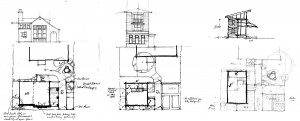 Our Design Process
Our Design Process
Opticos marries the world of hand drawing with digital modeling to leverage the talents of our staff with the efficiencies gained through digital modeling.
Our design process starts, as it invariably always does, with hand sketches on trace for typical lot sizes. Rough site plans and simple drafted elevations are quickly produced to create a diverse architectural palette of carriage houses, traditional tudor, a contemporary loft, and a small footprint “treehouse.”
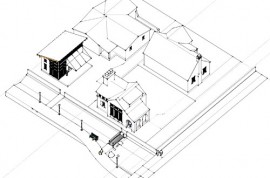
These plans are imported into Google Sketchup, where we are able to refine the details and construct the buildings in three dimensions. Using Google Sketchup’s ability to bring in aerial photography of specific locations, we are able to place these prototypical carriage houses onto real world lots and situations. Often at this point, we create a new perspective view from this simple Sketchup model and hand draw and render the final image. However, in this case we had the opportunity to take the model and rendering to another level of design detail.
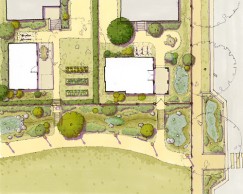
A plan view of the Sketchup model was printed so that additional design elements could be added for the individual sites and the Greenway. This plan was then rendered and imported into Sketchup and used as a base for the model. An axonometric drawing was created from the model and exported to Photoshop where the final image was created.
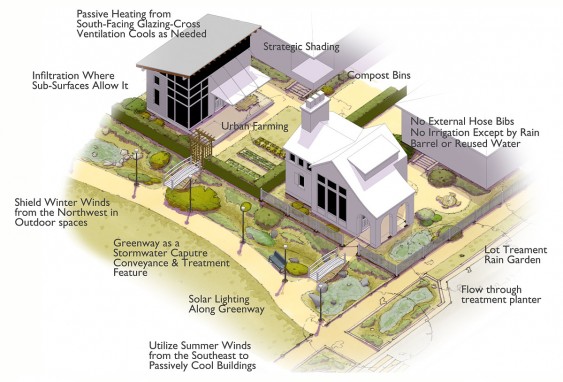
Google Sketchup’s Photomatch was used to match the model to a photograph that was taken earlier in the day. This composite image of the model and photograph was used as the underlay for a hand-drawn eye-level perspective.
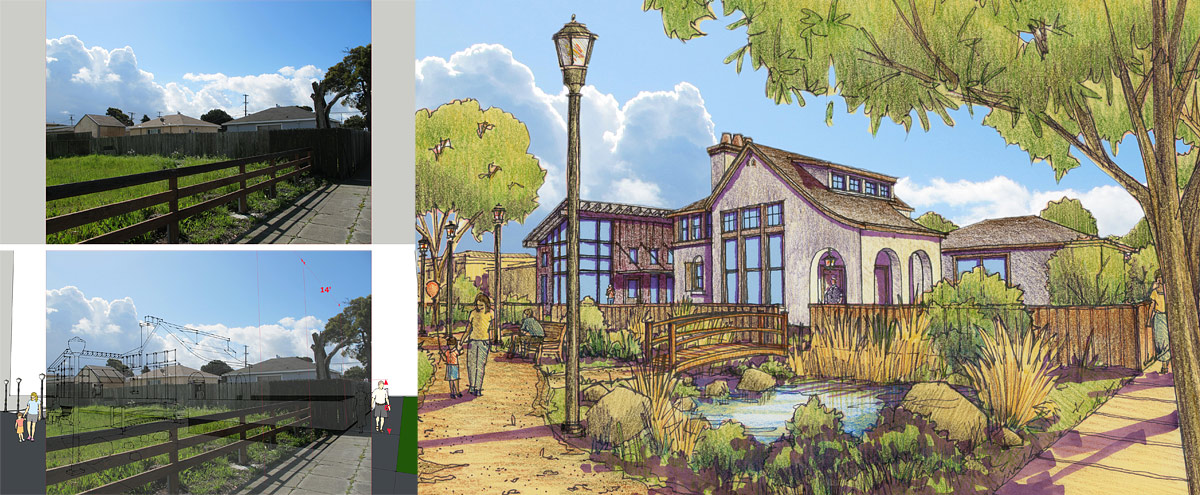 The combination of quick hand drawing and rendering, and the efficieny of using Google Sketchup to create multiple images from one model, allowed us to efficiently create a series of drawings during a compressed two-day period.
The combination of quick hand drawing and rendering, and the efficieny of using Google Sketchup to create multiple images from one model, allowed us to efficiently create a series of drawings during a compressed two-day period.
Like this article? How about these: